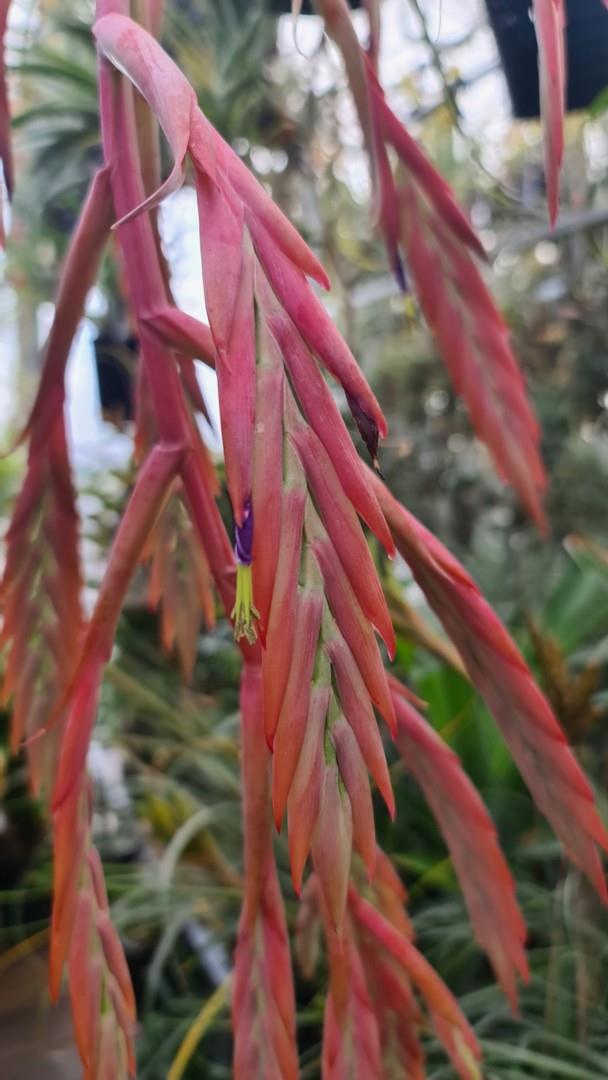
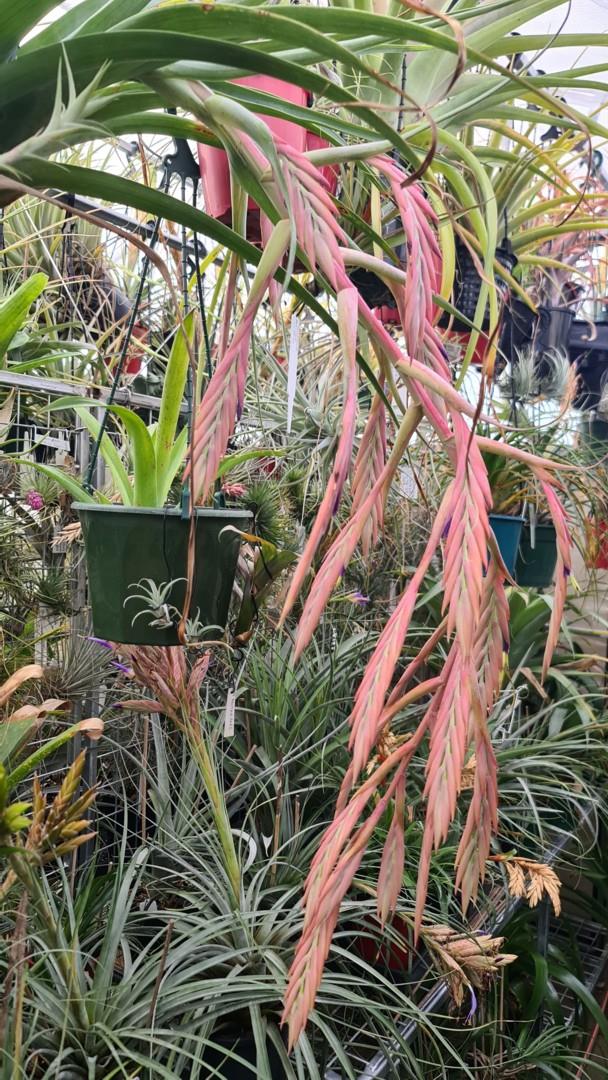
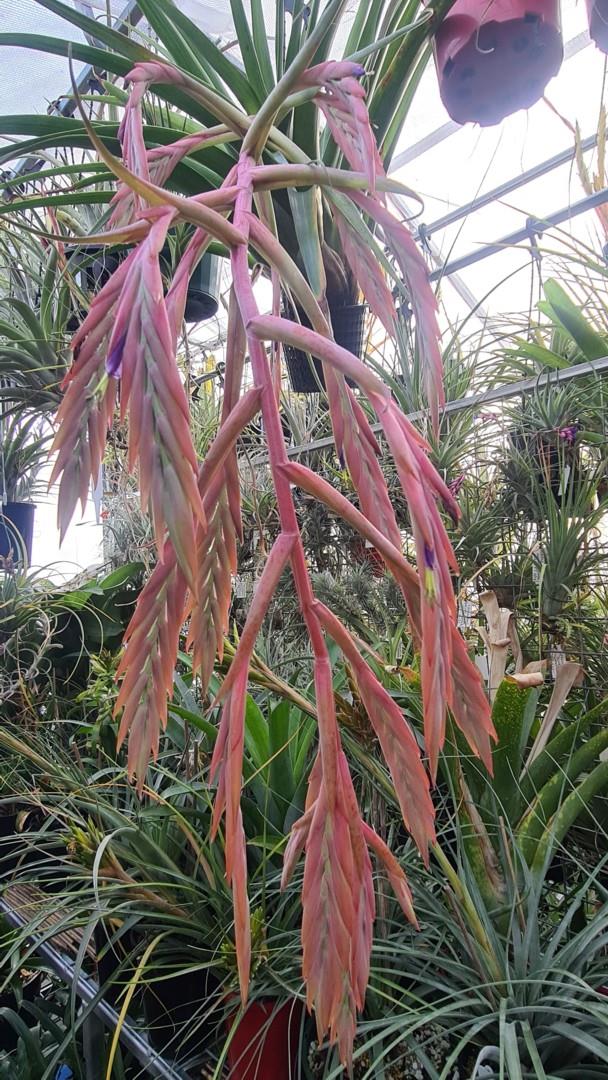
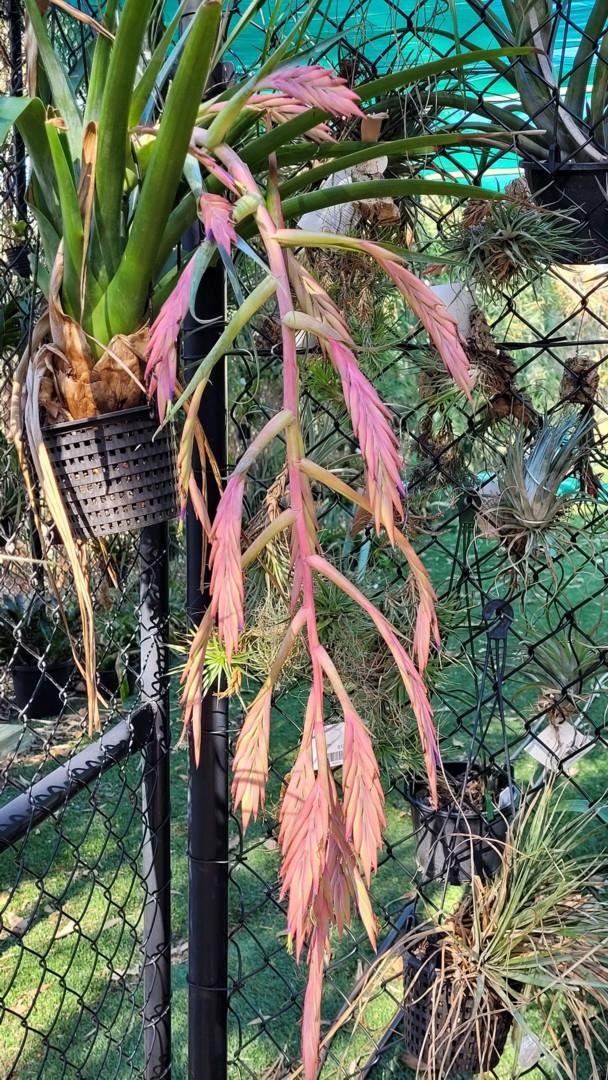
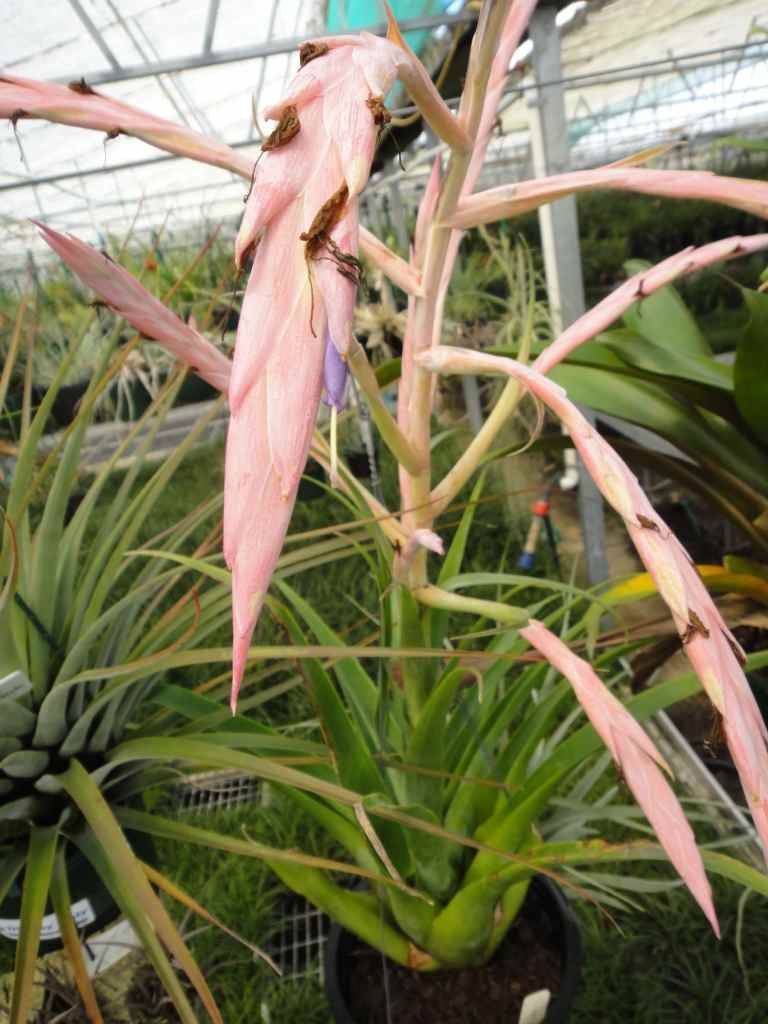
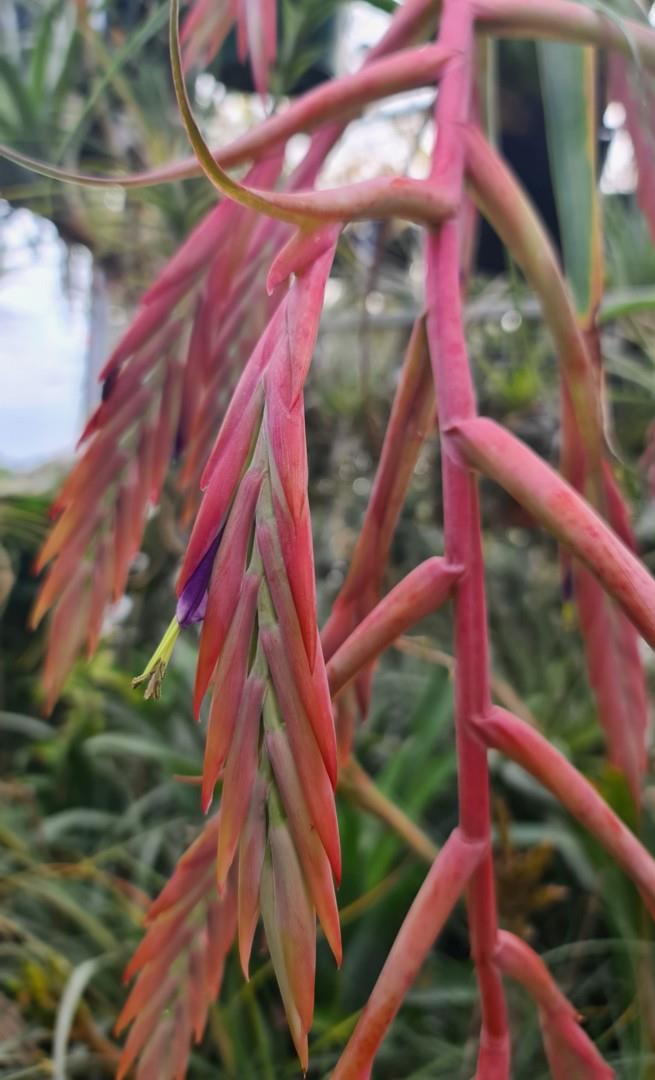
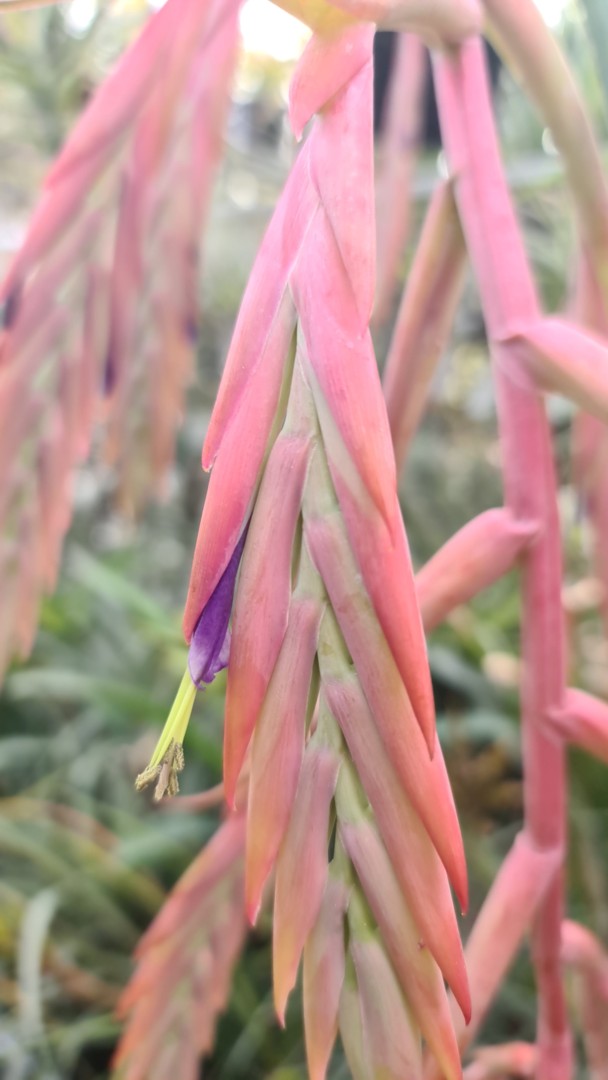
The plant differs from Tillandsia pamelae Rauh as follows: rosette narrow, less wide, leaves narrow, greenish-red, stronger chalky overlay, not ligulate but triangular long acuminate. Inflorescence subtripinnate, longer, the spikes longer however narrower. Floral bracts thick leathery, much narrower, hardly acuminate, not keeled. Sepals half as wide, petals wider, filament violet or green not white. Typus: Mexico, Estado Nuevo Leon, Sierra Zaragoza, Gral. Ignacio Zaragoza, Strasse nach Cerro Viejo, 1600-1700 m s. m., epilithisch, leg. L. Kohres s. n., 1989, Holotypus: MEXU, Isotypus WU;1. c., A. Lau s. n., 1980, Paratypus: WU; l. c., 25. 2. 1993, W. Schindhelm 2-93-32, Paratypus: WU; K. & R. Ehlers EM942004, 15. 3. 1994, Paratypus: WU. Weiteres Material von der gleichen Lokalitat leg. Wolfgang Schindhelm Berlin 25. 2. 1993 W. Sch. 2-93-32 (WU), EM 942004 leg. Klaus & Renate Ehlers 15. 3. 94 (WU).
Plant growing on rocks, stemless however with long, rhizome-like base with strong roots sticking to the rocks, at the base many adventitious offsets. Flowering plants 30 - 70 cm high, forming an upright, little extended rosette.
Leaves somewhat numerous, thin leathery, dark-green or green-red, on both sides dense very finely appressed scaled, strongly chalky all over, nerved.
Sheaths 10-18 cm long, 5-10 (-14 cm wide), oval, almost same color as blades only to the base somewhat brown.
Blades 3.5-5 cm wide over the sheath, narrow-triangular, tapering to a long, narrow, bent outwards tip.
Scape strong, almost lacking and covered by the rosette or to 25 cm long, bent over, imbricate from a few subfoliate scape bracts.
Inflorescence hanging or bent over, 25-100 (-125) cm long, 10-35 cm in diameter, laxly bipinnate or subtripinnate, from 5 to more than 20 side-branches, internodes 2-6 cm.
Side-branches 1-6 (-8) cm long stemmed, usually composed of from 1 however from up to 3 spikes, extending at an angle of 10-60degree.
Axis 7-10 mm in the diameter, pink, waxy, glabrous.
Primary bracts at the base with narrow-oval pink sheaths, glabrous, roughly as long or somewhat longer than the stem of the side-branches, the blade approximately 5 cm (-8) long, narrow triangular acuminate, the upper ones shorter and only short tipped.
Spikes 5-25 cm long, 1–2.5 (postfloral with seed –7) cm wide, lanceolate acuminate, complanate, with up to 15 densely imbricate, sessile, odourless flowers,
Rhachis somewhat flexuous, glabrous, angular hardly visible at anthesis, postfloral clearly visible.
Floral bracts 3.5–4.2 cm long, 1.3–1.7 cm wide, as long as the sepals or exceeding, narrow-oval, weakly acuminate, unkeeled, thick leathery, inside nerved, weakly but to the top somewhat more strongly minutely punctulate lepidote, outside pink chalky, glabrous, weakly punctulate scattered lepidote, nerved when dry.
Sepals 3–3.5 cm long, 7-8 mm wide, acuminate narrow-elliptical, green with pink top, leathery with subhyaline edges, strongly nerved, free, the posterior pair winged and thickened keel.
Petals 4.2–4.5 cm long, 9 mm wide, spatulate, hardly tapering to the base, somewhat acuminate, very succulent, a narrow, closed tube with a closed throat, the tips not bent outwards, dark-violet with white base.
Stamens protrude to 1.5 cm from the flower.
Filament 4.5-5 cm long, in 2 series of unequal length, in the upper part 1.1 mm in diameter, almost round, violet, towards the base more narrow, almost ribbon like, shining green-yellow.
Anthers 3.5-4 mm long, 1 mm wide, dark brown, versatile, joined 1/4 from the base.
Pollen egg yellow.
Style 3.7-4 mm long, greenish,
Stigma little wider than the style, 2.5 mm long, 1.2 mm wide, Lobes quite upright, black-lilac, Type I Brown & Gilmartin.
Ovary 9 mm high, at the base 3 mm wide, conic,
Capsule 3.5 cm long.
The Tillandsia key of L. B. Smith leads nowhere. On the basis of its hanging inflorescence and the chalky covering to the leaves and Inflorescence, the plant has a similarity with Tillandsia pamelae Rauh.
It differs from this in the following characteristics:
Rosette narrow, less extended,
Leaves narrow, green-red, more strongly chalky all over, not ligulate but long triangular acuminate.
Inflorescence subtripinnate, longer,
Spikes longer however narrower.
Floral bracts thick leathery, much narrower, hardly acuminate, unkeeled.
Sepals only half as wide,
Petals wide,
Filament violet not white.
T. pamelae Rauh, collected at type locality, in Mexico, Jalisco, on the Talpa de Allende road, 1800 msm. by Klaus & Renate Ehlers, EM 902201, WU. March 1990, bloomed in the summer 1993 in collection of Ehlers. It differed from the description in that, the inflorescence was not only from 5-8 spikes but from more than 20. The floral bracts were not lanceolate but wide-oval and long acuminate, at the same time somewhat shorter than the sepals, however not or hardly keeled, very much thin membranous and white.
Notes
In 1984, we obtained a plant of this striking Tillandsia with exact location details from Alfred Lau, Fortin de las Flores, Mexico, who had discovered this plant. He also gave us a beautiful photo of one of his Indian boys, with a plant in his hand whose inflorescence was almost as large as the boy himself. In 1986 the plant flowered in our collection and the flower was green with a somewhat restricted throat of the flower tube.
In 1989, Lydia and Gerhard Kohres collected at the Cerro Viejo this Tillandsia and also from Lydia, there is a photo at the location of a gigantic flowering plant. Lydia brought some plants, from which also I got some. To my astonishment one of these plants flowered violet. Later Wolfgang Schindhelm from Berlin collected further material from the same locality, leg. 25. 2. 1993 W. Sch. 2-93-32 (WU).
It now turned out that they could not predict which flower colour the plants will have, it flowered partially violet, but the other part was however yellowish green. Finally in 1994, Klaus and I drove to Zaragoza and collected the meanwhile legendary Tillandsia, Klaus & Renate Ehlers EM 942004, 15.03.94.
It was necessary that we found out whether two very similar looking plants grew at this location.
It was the last trip that I could do with Klaus. We knew the area well from our cactus days, because there is a whole range of rare and interesting cactus in this habitat, and we had traveled this area many times.
From our diary of the trip - 15. March 1994: we drive over to Dr. Arroyo towards Aramberry, (near Dr. Arroyos we had, the year before collected T. erubescens var. arroyoensis in the snow! This variety of T. erubescens was therefore named after this place: var. arroyoensis). In Aramberry, we are glad to receive a room in the only small hotel. The next morning, we drive to General Ignazio Zaragoza and from there a very steep road after Encantada in the direction of Siberia. Here, the trees are full with T. erubescens var. arroyoensis and T. sueae. We look for a plant, that Lydia and Gerhard Kohres had collected there and from which we wanted to determine whether it could be a hybrid. Although we have received a very exact description of the place, we don't find it nor find any plant. We therefore turn back and drive to the Cerro Viejo. At the car, we measure the height: 1588 m s.m. It begins to rain. We climb to a rock-wall to find out what may be there and find two plants. We see small differences, one plant is somewhat gray and other one reddish, but it seemed only one species. We scan the rocks for a long while and collect some plants. From top to toe we are wet and dirty as we get back to the car. When we get to the hotel, we sneak quickly to our room, because we look truly awful!
Unfortunately, we had drawn lots in trying to solve this riddle of these plants because even the plants collected by us flower partly violet, partly greenish yellow. I tried to match the plants and inflorescences so I could describe them. It seems there is no link other than a single factor that remained constant, which was: the green flowers had a somewhat wider opening in the throat of the flower tube and the petals were less solid.
For a long time we discussed the problem with Jurgen Lautner as to whether two different species grow near the Cerro Viejo. In 1996, he was at the location and brought us many, beautiful photos. A plant on the rock-wall flowered exactly. It had violet flowers. Also he reported that the Tillandsia is probably somewhat variable and only one single species seems there.
It must therefore be assumed that the plants, caused by unknown circumstances, that I cannot recognize so far, sometimes violet flowers and some times yellow green.
Dr. Walter Till suspected that it could be easily be about one hybrid. This is certainly one answer. At the location, plants occur on the seemingly large rock wall. In the near surroundings there are no other Tillandsis species, only about 20 km away in the direction of Siberia grows T. sueae and T. erubescens; these species do not appear to be possible parents, however.
After the plant has now been watched and examined for almost 20 years, it is about time that it is described as a new species.
Summary:
A new epilithic species of Tillandsia, T. zaragozaensis from Mexico, Est. Nuevo Leon, near Zaragoza is described here.
This medium to large sized plant is characterised by a few-leaved, funnel-shaped rosette and a long, dangling or bent over, 1-3 times branched inflorescence. It has been known to be new at least for the last 20 years. The author restrained from publication up to now because the individuals of the population were observed to have flowers that were either violet or yellow, and it had to be clarified whether both belong to the same species or not. A hybrid origin appears unlikely, no parental species occur in that area. In addition, anecdotes of the discovery and examination of the plants in the field are reported.